Effects of Exposure to Trade Antifouling Paints and Biocides on Larval Settlement and Metamorphosis of the Compound Ascidian Botryllus schlosseri
Abstract
:1. Introduction
2. Materials and Methods
2.1. Larval Collection
2.2. Antifouling Paints
2.3. Antifouling Biocides
2.4. Statistical Analysis
3. Results and Discussion
3.1. Effects of Antifouling Paints
3.2. Effects of Antifouling Biocides
3.3. Larval Abnormalities
4. Conclusions
Author Contributions
Funding
Institutional Review Board Statement
Informed Consent Statement
Data Availability Statement
Acknowledgments
Conflicts of Interest
References
- Delsuc, F.; Tsagkogeorga, G.; Lartillot, N.; Philippe, H. Additional molecular support for the new chordate phylogeny. Genesis 2008, 46, 592–604. [Google Scholar] [CrossRef] [PubMed] [Green Version]
- Cloney, R.A. Ascidian larvae and the events of metamorphosis. Am. Zool. 1982, 22, 817–826. [Google Scholar] [CrossRef] [Green Version]
- Karaiskou, A.; Swalla, B.J.; Sasakura, Y.; Chambon, J.-P. Metamorphosis in solitary ascidians. Genesis 2014, 53, 34–47. [Google Scholar] [CrossRef] [PubMed]
- Hotta, K.; Dauga, D.; Manni, L. The ontology of the anatomy and development of the solitary ascidian Ciona: The swimming larva and its metamorphosis. Sci. Rep. 2020, 10, 17916. [Google Scholar] [CrossRef]
- Sasakura, Y.; Hozumi, A. Formation of adult organs through metamorphosis in ascidians. WIREs Dev. Biol. 2018, 7, e304. [Google Scholar] [CrossRef]
- Caicci, F.; Zaniolo, G.; Burighel, P.; Degasperi, V.; Gasparini, F.; Manni, L. Differentiation of papillae and rostral sensory neurons in the larva of the ascidian Botryllus schlosseri (Tunicata). J. Comp. Neurol. 2010, 518, 547–566. [Google Scholar] [CrossRef]
- Pennati, R.; Rothbächer, U. Bioadhesion in ascidians: A developmental and functional genomics perspective. Interface Focus 2015, 5, 20140061. [Google Scholar] [CrossRef]
- Wakai, M.K.; Nakamura, M.J.; Sawai, S.; Hotta, K.; Oka, K. Two-round Ca2+ transient in papillae by mechanical stimulation induces metamorphosis in the ascidian Ciona intestinalis type A. Proc. R. Soc. B 2021, 288, 20203207. [Google Scholar] [CrossRef]
- Aldred, N.; Clare, A.S. Mini-review: Impact and dynamics of surface fouling by solitary and compound ascidians. Biofouling 2014, 30, 259–270. [Google Scholar] [CrossRef] [PubMed]
- Bryan, G.W.; Gibbs, P.E.; Burt, G.R.; Hummerstone, L.G. The decline of the gastropod Nucella lapillus around southwest England: Evidence for the effects of tributyltin from antifouling paints. J. Mar. Biol. Assoc. UK 1986, 66, 611–640. [Google Scholar] [CrossRef]
- Henderson, A.S.; Salazar, S.M. Flowthrough bioassay studies on the effects of antifouling TBT leachates. In Organotin: Environmental Fate and Effects; Champ, M.A., Seligman, P.F., Eds.; Chapman & Hall: London, UK, 1996; pp. 281–303. [Google Scholar]
- Hoch, M. Organotin compounds in the environment: An overview. Appl. Geochem. 2001, 16, 719–743. [Google Scholar] [CrossRef]
- Cima, F.; Craig, P.J.; Harrington, C. Organotin compounds in the environment. In Organometallic Compounds in the Environment; Craig, P.J., Ed.; Wiley & Sons Ltd.: Chichester, UK, 2003; pp. 101–149. [Google Scholar]
- Guardiola, F.A.; Cuesta, A.; Meseguer, J.; Esteban, M.A. Risks of using antifouling biocides in aquaculture. Int. J. Mol. Sci. 2012, 13, 1541–1560. [Google Scholar] [CrossRef]
- Voulvoulis, N.; Scrimshaw, M.D.; Lester, J.N. Alternative antifouling biocides. Appl. Organomet. Chem. 1999, 13, 135–143. [Google Scholar] [CrossRef]
- Evans, S.M.; Birchenough, A.C.; Brancato, M.S. The TBT ban: Out of the frying pan into the fire? Mar. Pollut. Bull. 2000, 40, 204–211. [Google Scholar] [CrossRef]
- Omae, I. Organotin antifouling paints and their alternatives. Appl. Organomet. Chem. 2003, 17, 81–105. [Google Scholar] [CrossRef]
- Konstantinou, I.K.; Albanis, T.A. Worldwide occurrence and effects of antifouling paint booster biocides in the aquatic environment: A review. Environ. Int. 2004, 30, 235–248. [Google Scholar] [CrossRef]
- Cima, F.; Ballarin, L.; Bressa, G.; Martinucci, G.B.; Burighel, P. Toxicity of organotin compounds on embryos of a marine invertebrate (Styela plicata; Tunicata). Ecotoxicol. Environ. Saf. 1996, 35, 174–182. [Google Scholar] [CrossRef] [PubMed]
- Zega, G.; Pennati, R.; Candiani, S.; Pestarino, M.; De Bernardi, F. Solitary ascidians embryos (Chordata, Tunicata) as model organisms for testing coastal pollutant toxicity. Invertebr. Surv. J. 2009, 6, S29–S34. [Google Scholar]
- Zaniolo, G.; Burighel, P.; Martinucci, G. Ovulation and placentation in Botryllus schlosseri (Ascidiacea): An ultrastructural study. Can. J. Zool. 1987, 65, 1181–1190. [Google Scholar] [CrossRef]
- Manni, L.; Zaniolo, G.; Burighel, P. Ultrastructural study of oogenesis in the compound ascidian Botryllus schlosseri (Tunicata). Acta Zool. 1994, 75, 101–113. [Google Scholar] [CrossRef]
- Gasparini, F.; Manni, L.; Cima, F.; Zaniolo, G.; Burighel, P.; Caicci, F.; Franchi, N.; Schiavon, F.; Rigon, F.; Campagna, D.; et al. Sexual and asexual reproduction in the colonial ascidian Botryllus schlosseri. Genesis 2014, 53, 105–120. [Google Scholar] [CrossRef] [Green Version]
- Cima, F.; Ballarin, L. A proposed integrated bioindex for the macrofouling biocoenosis of hard substrata in the lagoon of Venice. Estuar. Coast. Shelf Sci. 2013, 130, 190–201. [Google Scholar] [CrossRef]
- Manni, L.; Zaniolo, G.; Cima, F.; Burighel, P.; Ballarin, L. Botryllus schlosseri: A model ascidian for the study of asexual reproduction. Dev. Dyn. 2007, 236, 335–352. [Google Scholar]
- Manni, L.; Anselmi, C.; Cima, F.; Gasparini, F.; Voskoboynik, A.; Martini, M.; Peronato, A.; Burighel, P.; Zaniolo, G.; Ballarin, L. Sixty years of experimental studies on the blastogenesis of the colonial tunicate Botryllus schlosseri. Dev. Biol. 2019, 448, 293–308. [Google Scholar] [CrossRef] [PubMed]
- Ben-Hamo, O.; Rinkevich, B. Botryllus schlosseri—A model colonial species in basic and applied studies. In Handbook of Marine Model Organisms in Experimental Biology; Established and Emerging; Boutet, A., Schierwater, B., Eds.; CRC Press, Taylor & Francis Group: Boca Raton, FL, USA, 2021; pp. 385–402. [Google Scholar]
- Cima, F.; Ballarin, L.; Bressa, G.; Sabbadin, A. Immunotoxicity of butyltins in tunicates. Appl. Organomet. Chem. 1995, 9, 567–572. [Google Scholar] [CrossRef]
- Cima, F.; Bragadin, M.; Ballarin, L. Toxic effects of new antifouling compounds on tunicate haemocytes—I. Sea-Nine 211™ and chlorothalonil. Aquat. Toxicol. 2008, 86, 299–312. [Google Scholar] [CrossRef]
- Menin, A.; Ballarin, L.; Bragadin, M.; Cima, F. Immunotoxicity in ascidians: Antifouling compounds alternative to organotins—II. The case of diuron and TCMS pyridine. J. Environ. Sci. Health 2008, 43B, 644–654. [Google Scholar] [CrossRef] [PubMed]
- Cima, F.; Ballarin, L. Immunotoxicity in ascidians: Antifouling compounds alternative to organotins: III—The case of copper(I) and Irgarol 1051. Chemosphere 2012, 89, 19–29. [Google Scholar] [CrossRef] [PubMed]
- Cima, F.; Ballarin, L. Immunotoxicity in ascidians: Antifouling compounds alternative to organotins—IV. The case of zinc pyrithione. Comp. Biochem. Physiol. 2015, 169, 16–24. [Google Scholar] [CrossRef]
- Kiil, S.; Dam-Johansen, K.; Weinell, C.E.; Pedersen, M.S.; Codolar, S.A. Estimation of polishing and leaching behaviour of antifouling paints using mathematical modelling: A literature review. Biofouling 2003, 19, 37–43. [Google Scholar] [CrossRef]
- Takahashi, K. Release rate of biocides from antifouling paints. In Ecotoxicology of Antifouling Biocides; Arai, T., Harino, H., Ohji, M., Langston, W.J., Eds.; Springer: Tokyo, Japan, 2009; pp. 3–22. [Google Scholar]
- Marin, M.G.; Moschino, V.; Cima, F.; Celli, C. Embryotoxicity of butyltin compounds to the sea urchin Paracentrotus lividus. Mar. Environ. Res. 2000, 50, 231–235. [Google Scholar] [CrossRef]
- Khandeparker, L.; Desai, D.; Shirayama, Y. Larval development and post-settlement metamorphosis of the barnacle Balanus albicostatus Pilsbry and the serpulid polychaete Pomatoleios kraussii Baird: Impact of a commonly used antifouling biocide, Irgarol 1051. Biofouling 2005, 21, 169–180. [Google Scholar] [CrossRef] [PubMed]
- Bellas, J. Comparative toxicity of alternative antifouling biocides on embryos and larvae of marine invertebrates. Sci. Total Environ. 2006, 367, 573–585. [Google Scholar] [CrossRef] [PubMed]
- Manzo, S.; Buono, S.; Cremisini, C. Toxic effects of irgarol and diuron on sea urchin Paracentrotus lividus early development, fertilization, and offspring quality. Arch. Environ. Contam. Toxicol. 2006, 51, 61–68. [Google Scholar] [CrossRef]
- Mai, H.; Morin, B.; Pardon, P.; Gonzalez, P.; Budzinski, H.; Cachot, J. Environmental concentrations of irgarol, diuron and s-metolachlor induce deleterious effects on gametes and embryos of the Pacific oyster, Crassostrea gigas. Mar. Environ. Res. 2013, 89, 1–8. [Google Scholar] [CrossRef]
- Gallo, A.; Tosti, E. Reprotoxicity of the antifoulant chlorothalonil in ascidians: An ecological risk assessment. PLoS ONE 2015, 10, e0123074. [Google Scholar] [CrossRef]
- Dumollard, R.; Gazo, I.; Gomes, I.D.L.; Besnardeau, L.; McDougall, A. Ascidians: An emerging marine model for drug discovery and screening. Curr. Top. Med. Chem. 2017, 17, 2056–2066. [Google Scholar] [CrossRef] [PubMed]
- Antizar-Ladislao, B. Environmental levels, toxicity and human exposure to tributyltin (TBT)-contaminated marine environment. A review. Environ. Int. 2008, 34, 292–308. [Google Scholar] [CrossRef]
- Bellas, J. Toxicity assessment of the antifouling compound zinc pyrithione using early developmental stages of the ascidian Ciona intestinalis. Biofouling 2005, 21, 289–296. [Google Scholar] [CrossRef]
- Bellas, J.; Beiras, R.; Vazquez, E. Sublethal effects of trace metals (Cd, Cr, Cu, Hg) on embryogenesis and larval settlement of the ascidian Ciona intestinalis. Arch. Environ. Contam. Toxicol. 2004, 46, 61–66. [Google Scholar] [CrossRef]
- Mackie, D.S.; van den Berg, C.M.G.; Readman, J.W. Determination of pyrithione in natural waters by cathodic stripping voltametry. Anal. Chim. Acta 2004, 511, 47–53. [Google Scholar] [CrossRef]
- Ranke, J.; Jastorff, B. Multidimensional risk analysis of antifouling biocides. Environ. Sci. Pollut. Res. 2000, 7, 105–114. [Google Scholar] [CrossRef] [PubMed]
- Kiaune, L.; Singhasemanon, N. Pesticidal copper (I) oxide: Environmental fate and aquatic toxicity. Rev. Environ. Contam. Toxicol. 2011, 213, 1–26. [Google Scholar] [PubMed]
- Lagerström, M.; Ytreberg, E. Quantification of Cu and Zn in antifouling paint films by XRF. Talanta 2021, 223, 121820. [Google Scholar] [CrossRef]
- Hartl, M.G.J.; Hutchinson, S.; Hawkins, L.E. Organotin and osmoregulation: Quantifying the effects of environmental concentrations of sediment-associated TBT and TPhT on the freshwater-adapted European flounder, Platichthys flesus (L.). J. Exp. Mar. Biol. Ecol. 2001, 256, 267–278. [Google Scholar] [CrossRef]
- Bregante, M.; Carpaneto, A.; Piazza, V.; Sbrana, F.; Vassalli, M.; Faimali, M.; Gambale, F. Osmoregulated chloride currents in hemocytes from Mytilus galloprovincialis. PLoS ONE 2016, 11, e0167972. [Google Scholar] [CrossRef] [PubMed] [Green Version]
- de Polo, A.; Scrimshaw, M.D. Challenges for the development of a biotic ligand model predicting copper toxicity in estuaries and seas. Environ. Toxicol. Chem. 2012, 31, 230–238. [Google Scholar] [CrossRef] [Green Version]
- Haque, M.N.; Eom, H.-J.; Nam, S.-E.; Shin, Y.K.; Rhee, J.-S. Chlorothalonil induces oxidative stress and reduces enzymatic activities of Na+/K+-ATPase and acetylcholinesterase in gill tissues of marine bivalves. PLoS ONE 2019, 14, e0214236. [Google Scholar] [CrossRef] [PubMed]
- Cima, F.; Dominici, D.; Mammi, S.; Ballarin, L. Butyltins and calmodulin: Which interaction? Appl. Organomet. Chem. 2002, 16, 182–186. [Google Scholar] [CrossRef]
- Cima, F.; Ballarin, L. Tributyltin induces cytoskeletal alterations in the colonial ascidian Botryllus schlosseri phagocytes via interaction with calmodulin. Aquat. Toxicol. 2000, 48, 419–429. [Google Scholar] [CrossRef]
- Cima, F.; Ballarin, L. TBT-induced apoptosis in tunicate haemocytes. Appl. Organomet. Chem. 1999, 13, 697–703. [Google Scholar] [CrossRef]
- Schiaffino, S.; Burighel, P.; Nunzi, M.G. Involution of the caudal musculature during metamorphosis in the ascidian, Botryllus schlosseri. Cell Tissue Res. 1974, 153, 293–305. [Google Scholar] [CrossRef]
- Whittaker, J.R. Copper as a factor in the onset of ascidian metamorphosis. Nature 1964, 202, 1024–1025. [Google Scholar] [CrossRef] [PubMed]
- Bragadin, M.; Manente, S.; Marton, D.; Cima, F.; Rigobello, M.P.; Bindoli, A. The interaction of zinc pyrithione with mitochondria from rat liver and a study of the mechanism of inhibition of ATP synthesis. Appl. Organomet. Chem. 2003, 17, 869–874. [Google Scholar] [CrossRef]
- Bragadin, M.; Cima, F.; Ballarin, L.; Manente, S. Irgarol inhibits the synthesis of ATP in mitochondria from rat liver. Chemosphere 2006, 65, 1898–1903. [Google Scholar] [CrossRef] [PubMed]
- Bragadin, M.; Iero, A.; Cima, F.; Ballarin, L.; Manente, S. TCMS inhibits ATP synthesis in mitochondria: A systematic analysis of the inhibitory mechanism. Toxicol. In Vitro 2007, 21, 1127–1133. [Google Scholar] [CrossRef] [PubMed]
- Bishop, C.D.; Bates, W.R.; Brandhorst, B.P. Regulation of metamorphosis in ascidians involves NO/cGMP signaling and HSP90. J. Exp. Zool. 2001, 289, 374–384. [Google Scholar] [CrossRef] [PubMed]
- Ferruzza, S.; Scarino, M.L.; Rotilio, G.; Ciriolo, M.R.; Santaroni, P.; Muda, A.O.; Sambuy, Y. Copper treatment alters the permeability of tight junctions in cultured human intestinal Caco-2 cells. Am. J. Physiol. 1999, 277, 1138–1148. [Google Scholar] [CrossRef] [PubMed]
- Chung-Hsun, L.; I-Hui, C.; Chia-Rong, L.; Chih-Hsien, C.; Ming-Che, T.; Jin-Lian, T.; Hsiu-Fen, L. Inhibition of gap junctional intercellular communication in WB-F344 rat liver epithelial cells by triphenyltin chloride through MAPK and PI3-kinase pathways. J. Occup. Med. Toxicol. 2010, 5, 17. [Google Scholar]
- European Commission. Directive 98/8/EC of the European Parliament and of the Council of 16 February Concerning the Placing of Biocidal Products on the Market. Off. J. Eur. Comm. 1998, 41, 123. [Google Scholar]
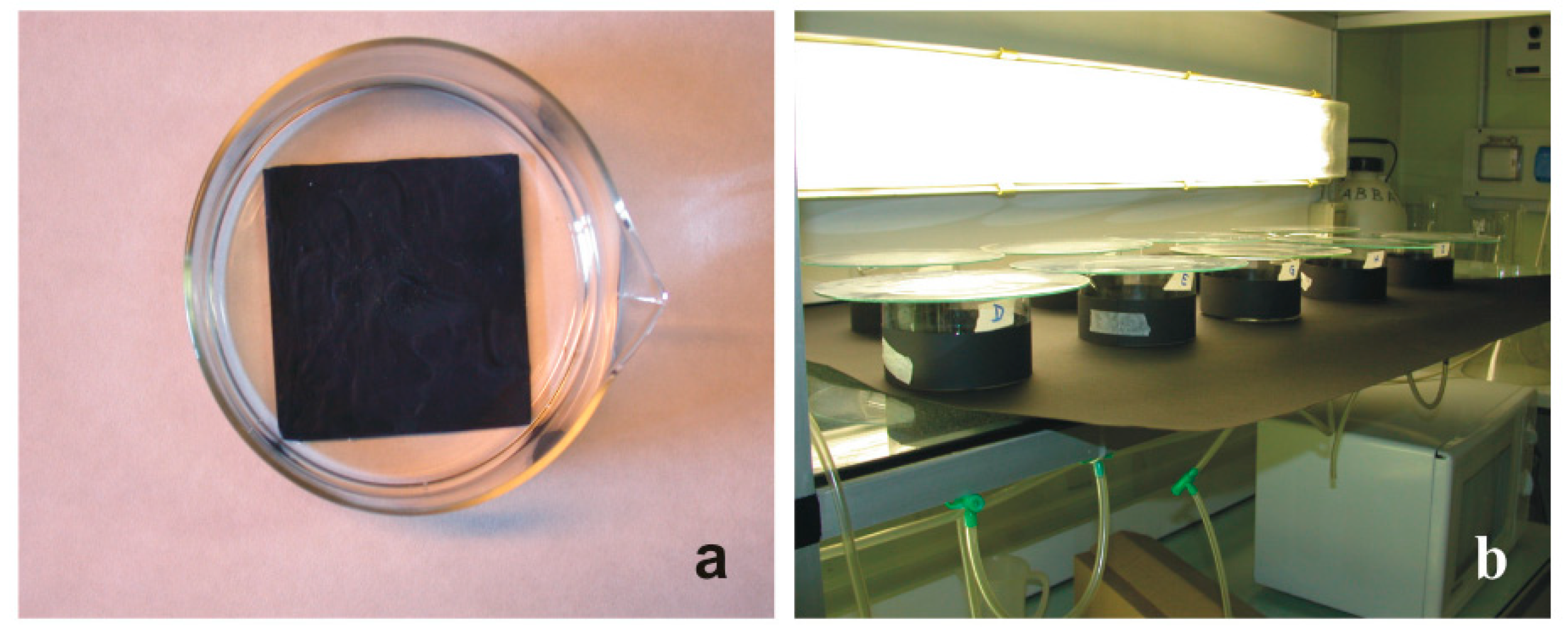
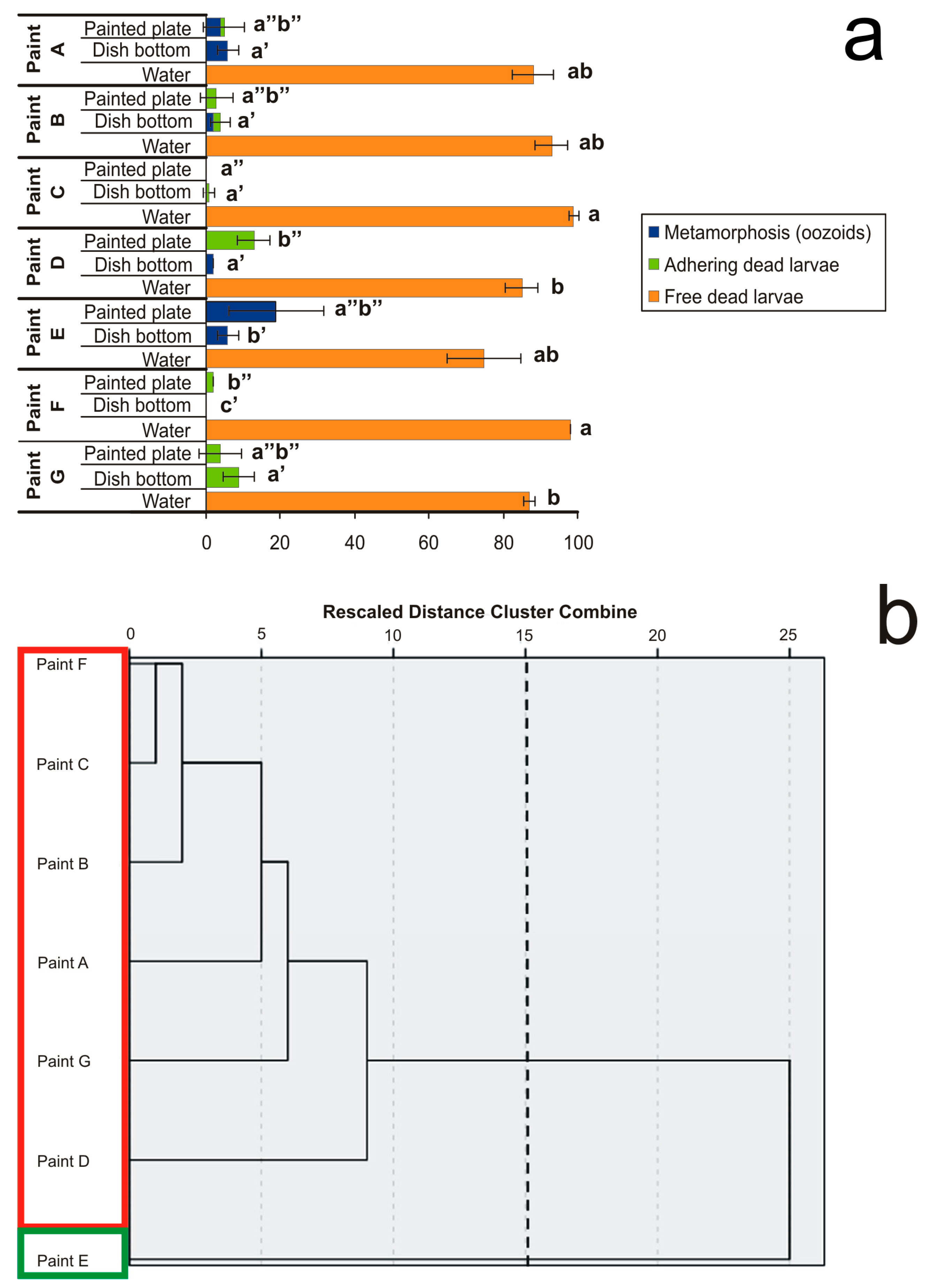
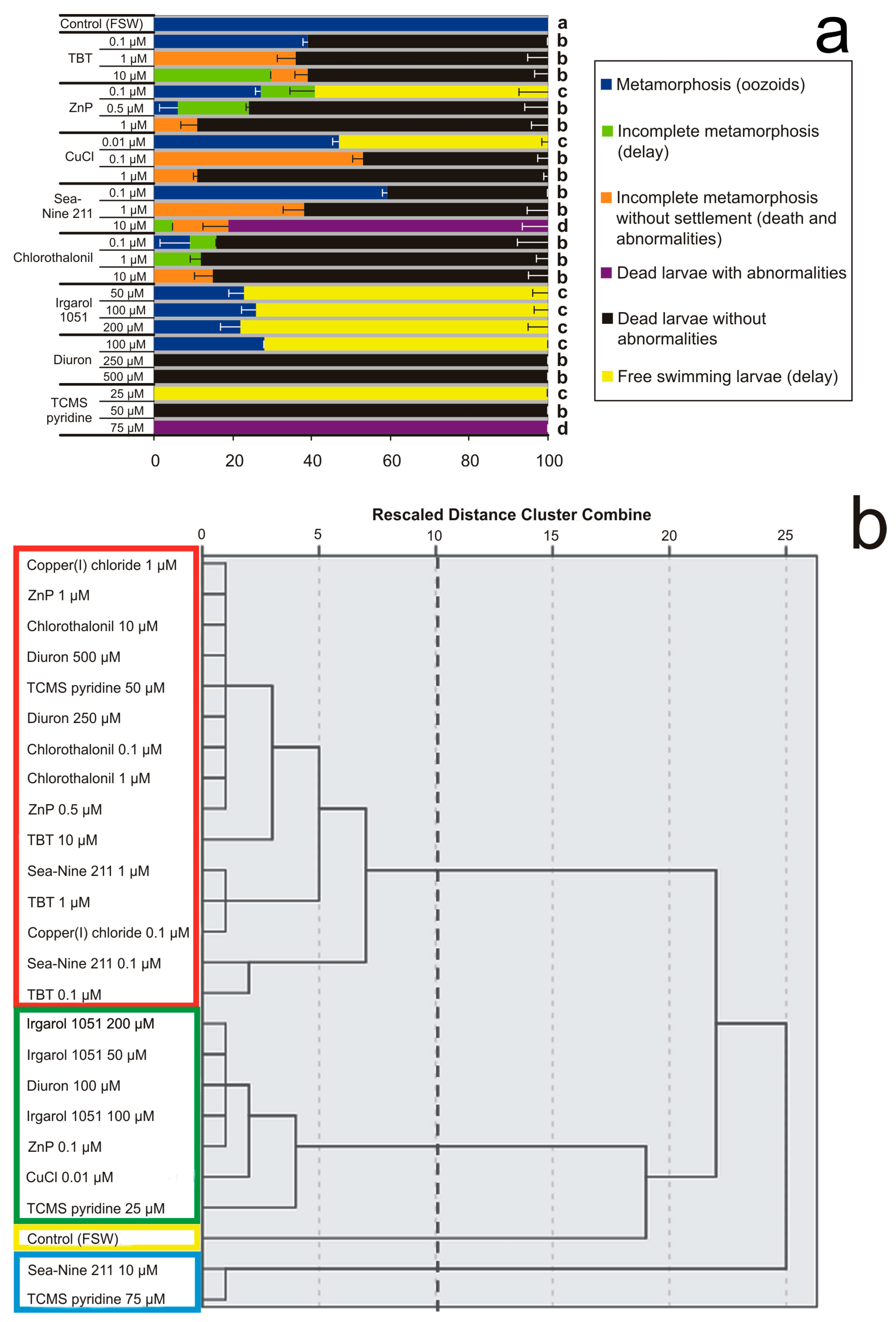

| Chemical Name | CAS | Trademark(s) | Other Uses |
|---|---|---|---|
| zinc 2-pyridinethiol-oxide | 13463-41-7 | Zinc pyrithione, ZnP | Antimicrobial, fungicide in antidandruff shampoo, antiseborrheic, preservative in cosmetics |
| zinc N-[2(sulfidocarbothioylamino)ethyl]carbamodithioate | 9006-42-2 | Zineb, Metiram, Amarex, Polyram, Polycarbacin, Parzate, Dithane, Z-78 | Fungicide |
| copper(I) oxide | 1317-39-1 | Cuprous oxide, Dicopper monoxide, Red copper oxide | Antimicrobial, fungicide, pigment, catalyst |
| copper(I) thiocyanate | 1111-67-7 | Cuprous thiocyanate, Copper sulfocyanide, Thiocyanic acid copper (I) salt | Antimicrobial, fungicide, paint additive |
| 4,5-dichloro-2-n-octyl-4-isothiazolin-3-one | 64359-81-5 | Sea-Nine 211, DCOIT, Kathon 5287, C-9 | Fungicide for sealants, PVC, and wood |
| 2,4,5,6-tetrachloroisophthalonitrile | 1897-45-6 | Chlorothalonil, Bravo Daconil, Faber, Forturf, Nopcocide, Repulse, Termil, Tuffcide | Antimicrobial, fungicide, insecticide, acaricide |
| α,β-1,2,3,4,7,7-hexachlorobicyclo-[2.2.1]-2-heptene-5,6-bisoxymethylene sulfite | 33213-65-9 | Endosulfan, Benzoepin, BeositIndan, Sialan, Thiodan, Thiosulfan, Thionex, Thimul | Insecticide, acaricide |
| 2-N-tert-butyl-4-N-cyclopropyl-6-methylsulfanyl-1,3,5-triazine-2,4-diamine | 28159-98-0 | Irgarol 1051, Cybutryne | Herbicide |
| 3-(3,4-dichlorophenyl)-1,1-dimethylurea | 330-54-1 | Diuron, Duran, Dynex, Dichlorfenidim, Herbatox, Karmex, Telvar, Vonduron | Herbicide |
| 2,3,5,6-tetrachloro-4-(methylsulphonyl)pyridine | 13108-52-6 | TCMS pyridine, Davicil, Dowco-282 | Fungicide for leather and wood |
| Metamorphosis Stages | |
|---|---|
 | Stage 1 |
| |
 | Stage 2 |
| |
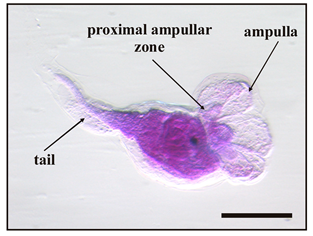 | Stage 3 |
| |
 | Stage 4 |
| |
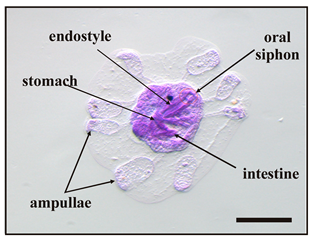 | Stage 5 |
| |
| Paint | Biocides | Matrix | Use | |
|---|---|---|---|---|
| A | Sigmaplane HB Antifouling | Cu2O (28%) TBT methacrylate (19%) TBTO (0.5%) | Self-polishing copolymers | Steel and wooden hull of fishing boats and cargo vessels more than 25 m in length (banned since 2003) |
| B | Marlin Velox TF | Zinc pyrithione (5–10%) Zineb (5–10%) Endosulfan (1–5%) | Contact leaching (hard or insoluble) | Propellers, shafts, and outdrives of fishing boats |
| C | Veneziani Propeller | CuSCN (7–10%) Zinc pyrithione (7–10%) Diuron (7–10%) Sea Nine 211 (1–3%) | Contact leaching (hard or insoluble) | Propellers, shafts, and outdrives of recreational craft |
| D | Veneziani Antialga | CuSCN (7–10%) Diuron (7.6%) Sea Nine 211 (2.7%) | Contact leaching (hard or insoluble) | Boattop of high-speed sailboats and powerboats |
| E | Sikkens Vinyl Antifouling 2000 | Cu2O (41%) | Contact leaching (hard or insoluble) | Steel (not aluminium), wooden, and polyester hull of sailboats and yachts |
| F | Baseggio Sirena Antivegetativa Universale | Cu2O (42%) Chlorothalonil (7%) Irgarol 1051 (1.1%) | Self-polishing copolymers | Steel, wooden, and fibreglass hull of fishing boats |
| G | Veneziani Even Extreme 2 (reactive component) | TCMS pyridine (1–5%) Diuron (1–5%) | Self-polishing based on two-pack Biomatrix technology | Steel, wooden, and fibreglass hull of racing yachts |
| Biocide | Species | LC50 | EC50 |
|---|---|---|---|
| TBT | B. schlosseri | 4.73 µM (1539 µg L−1) | 0.08 µM (26 µg L−1) |
| C. intestinalis | ND | 0.02 µM (7.1 µg L−1) [42] | |
| ZnP | B. schlosseri | 0.46 µM (146 µg L−1, 3 × 10−6 Zn wt%) | 0.06 µM (19 µg L−1, 4 × 10−6 Zn wt%) |
| C. intestinalis | ND | 0.11 µM (35 µg L−1, 7 × 10−6 Zn wt%) [43] | |
| Copper(I) chloride | B. schlosseri | 0.35 µM (34.6 µg L−1, 2 × 10−6 Cu wt%) | 0.04 µM (3.96 µg L−1, 2 × 10−6 Cu wt%) |
| C. intestinalis | ND | 1.61 µM (159 µg L−1, 1 × 10−3 Cu wt%) [44] | |
| Sea-Nine 211 | B. schlosseri | 4.88 µM (1377 µg L−1) | 0.25 µM (70 µg L−1) |
| C. intestinalis | ND | 0.15 µM (43 µg L−1) [37] | |
| Chlorothalonil | B. schlosseri | 4.80 µM (1276 µg L−1) | 0.23 µM (61 µg L−1) |
| C. intestinalis | ND | 0.16 µM (42 µg L−1) [37] | |
| Irgarol 1051 | B. schlosseri | >200 µM (>50,674 µg L−1) | 36 µM (9121 µg L−1) |
| C. intestinalis | ND | >25.60 µM (>6486 µg L−1) [37] | |
| Diuron | B. schlosseri | 214.96 µM (50,105 µg L−1) | 64 µM (14,918 µg L−1) |
| C. intestinalis | ND | ND | |
| TCMS pyridine | B. schlosseri | 34.99 µM (<10,392 µg L−1) | <25 µM (<7375 µg L−1) |
| C. intestinalis | ND | ND |
Publisher’s Note: MDPI stays neutral with regard to jurisdictional claims in published maps and institutional affiliations. |
© 2022 by the authors. Licensee MDPI, Basel, Switzerland. This article is an open access article distributed under the terms and conditions of the Creative Commons Attribution (CC BY) license (https://creativecommons.org/licenses/by/4.0/).
Share and Cite
Cima, F.; Varello, R. Effects of Exposure to Trade Antifouling Paints and Biocides on Larval Settlement and Metamorphosis of the Compound Ascidian Botryllus schlosseri. J. Mar. Sci. Eng. 2022, 10, 123. https://doi.org/10.3390/jmse10020123
Cima F, Varello R. Effects of Exposure to Trade Antifouling Paints and Biocides on Larval Settlement and Metamorphosis of the Compound Ascidian Botryllus schlosseri. Journal of Marine Science and Engineering. 2022; 10(2):123. https://doi.org/10.3390/jmse10020123
Chicago/Turabian StyleCima, Francesca, and Roberta Varello. 2022. "Effects of Exposure to Trade Antifouling Paints and Biocides on Larval Settlement and Metamorphosis of the Compound Ascidian Botryllus schlosseri" Journal of Marine Science and Engineering 10, no. 2: 123. https://doi.org/10.3390/jmse10020123







